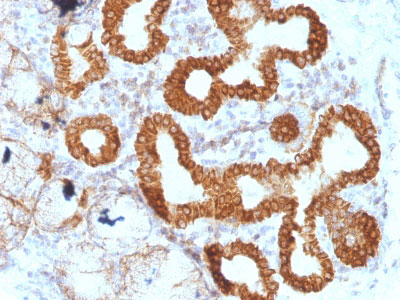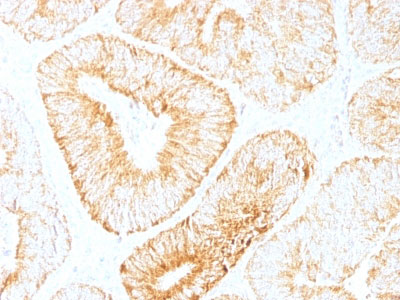IL-6 (Interleukin-6) / Interferon beta-2 (Hybridoma Growth Factor) Antibody - With BSA and Azide
Rat Monoclonal Antibody [Clone IL6/1270 ]
- SPECIFICATION
- CITATIONS
- PROTOCOLS
- BACKGROUND

Application
| IHC, IF, FC |
|---|---|
| Primary Accession | P05231 |
| Other Accession | 3569, 654458 |
| Reactivity | Human, Mouse |
| Host | Rat |
| Clonality | Monoclonal |
| Isotype | Rat / IgG1, kappa |
| Clone Names | IL6/1270 |
| Calculated MW | 21kDa |
| Gene ID | 3569 |
|---|---|
| Other Names | Interleukin-6, IL-6, B-cell stimulatory factor 2, BSF-2, CTL differentiation factor, CDF, Hybridoma growth factor, Interferon beta-2, IFN-beta-2, IL6, IFNB2 |
| Application Note | IHC~~1:100~500 IF~~1:50~200 FC~~1:10~50 |
| Storage | Store at 2 to 8°C.Antibody is stable for 24 months. |
| Precautions | IL-6 (Interleukin-6) / Interferon beta-2 (Hybridoma Growth Factor) Antibody - With BSA and Azide is for research use only and not for use in diagnostic or therapeutic procedures. |
| Name | IL6 (HGNC:6018) |
|---|---|
| Synonyms | IFNB2 |
| Function | Cytokine with a wide variety of biological functions in immunity, tissue regeneration, and metabolism. Binds to IL6R, then the complex associates to the signaling subunit IL6ST/gp130 to trigger the intracellular IL6-signaling pathway (Probable). The interaction with the membrane-bound IL6R and IL6ST stimulates 'classic signaling', whereas the binding of IL6 and soluble IL6R to IL6ST stimulates 'trans- signaling'. Alternatively, 'cluster signaling' occurs when membrane- bound IL6:IL6R complexes on transmitter cells activate IL6ST receptors on neighboring receiver cells (Probable). |
| Cellular Location | Secreted. |
| Tissue Location | Produced by skeletal muscle. |

Thousands of laboratories across the world have published research that depended on the performance of antibodies from Abcepta to advance their research. Check out links to articles that cite our products in major peer-reviewed journals, organized by research category.
info@abcepta.com, and receive a free "I Love Antibodies" mug.
Provided below are standard protocols that you may find useful for product applications.
Background
IL-6 is a potent lymphoid cell growth factor that stimulates the growth and survivability of certain B-cells and T-cells. It plays a critical role in B-cell differentiation to plasma cells and is a potent growth factor for plasmacytoma and myeloma. IL-6 is produced by a variety of cell types, including monocytes, fibroblasts and endothelial cells. Upon stimulation, macrophages, T, B, mast, and glial cells, eosinophils, keratinocytes and granulocytes also secrete IL-6. It is involved in host defense, acute phase reactions, immune responses, and hematopoiesis.
References
Hirano, T., et al. 1986. Complementary DNA for a novel human interleukin (BSF-2) that induces B lymphocytes to produce immunoglobulin. Nature 324: 73-76
If you have used an Abcepta product and would like to share how it has performed, please click on the "Submit Review" button and provide the requested information. Our staff will examine and post your review and contact you if needed.
If you have any additional inquiries please email technical services at tech@abcepta.com.













 Foundational characteristics of cancer include proliferation, angiogenesis, migration, evasion of apoptosis, and cellular immortality. Find key markers for these cellular processes and antibodies to detect them.
Foundational characteristics of cancer include proliferation, angiogenesis, migration, evasion of apoptosis, and cellular immortality. Find key markers for these cellular processes and antibodies to detect them. The SUMOplot™ Analysis Program predicts and scores sumoylation sites in your protein. SUMOylation is a post-translational modification involved in various cellular processes, such as nuclear-cytosolic transport, transcriptional regulation, apoptosis, protein stability, response to stress, and progression through the cell cycle.
The SUMOplot™ Analysis Program predicts and scores sumoylation sites in your protein. SUMOylation is a post-translational modification involved in various cellular processes, such as nuclear-cytosolic transport, transcriptional regulation, apoptosis, protein stability, response to stress, and progression through the cell cycle. The Autophagy Receptor Motif Plotter predicts and scores autophagy receptor binding sites in your protein. Identifying proteins connected to this pathway is critical to understanding the role of autophagy in physiological as well as pathological processes such as development, differentiation, neurodegenerative diseases, stress, infection, and cancer.
The Autophagy Receptor Motif Plotter predicts and scores autophagy receptor binding sites in your protein. Identifying proteins connected to this pathway is critical to understanding the role of autophagy in physiological as well as pathological processes such as development, differentiation, neurodegenerative diseases, stress, infection, and cancer.



